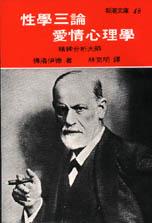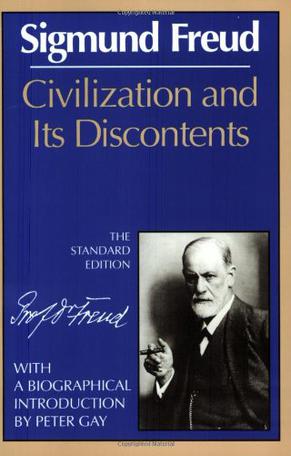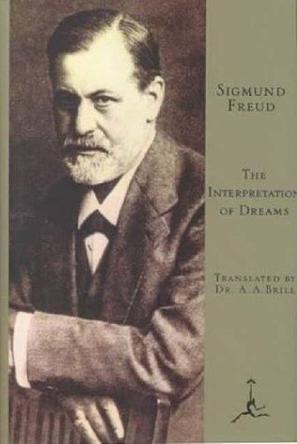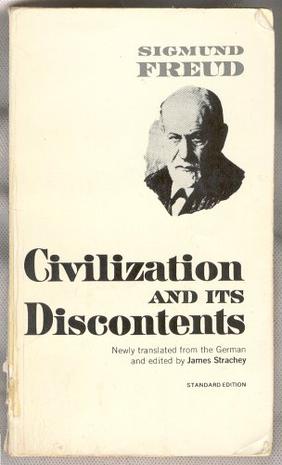欢迎来到相识电子书!
标签:Freud
-
性學三論:愛情心理學
「性學三論」乃是佛洛伊德對人性的了解最具創意、最永恆的貢獻之一,其革命性與重要性可與「夢的解析」等量齊觀。在本書中佛氏道出了對人性與人類行為動機的主要看法。第一篇「性變態」詳論同性戀、性錯亂、及心理症患者的性衝動。第二篇詳細分析幼兒性慾的來源、目的及其表達方式。第三篇「思春期的改變」,包含佛氏著名的原慾理論的經典。它不但是變態心理學學者們的至寶,更且由於它對人性發展作了有系統和完整的探討,也是心理學家、人類學家、社會學家以及一般知識份子所不可不讀的名著。「愛情心理學」包含三篇文章,其中對男人戀愛的畸形心理、性無能的原因,以及處女的謎樣的含意,都有精闢的分析,讀來令人回味無窮。 -
狼人的故事
弗洛伊德的案例分析著作主要有七篇,比如上世纪八十年代在中国“ 文青”人手一册的《少女杜拉的故事》就是其中之一。至于其他案例,一直没能译介过来。本书收的《狼人的故事》、《鼠人的故事》和《小汉斯的故事》三篇就是首次在内地出版(台湾去年出版了不同的译本)。这些案例涉及的患者包括从神经官能症到精神分裂症的多类病人,其症状在普通人看来也是相当奇特的。比如《鼠人的故事》的主人公,就经常感觉到老鼠从他的肛门钻了进去,因此痛苦不堪。弗洛伊德在案例分析过程中展现出非同寻常的洞察力,他对精神分析的深刻理解也是我们取之不尽的思想资源。 -
文明及其不满
《文明及其不满》英语规范、标准,行文流畅,适合文理各科大学生、研究生及广大英语自学者学习之用。“大学生英语文库”是一套面向中国大学生的英语系列读物,各本均为注释性读本,有助于通过研读文化经典,提高人文素养。《文明及其不满》是奥地利著名精神病学家、精神分析学派心理学创始人弗洛伊德晚年的作品之一。于1929年首次出版。作者在书中指出,人的本性是攻击性,以自我为中心,不断追求本能欲望的满足,而社会的发展则要求对个体的这种本能加以约束和控制。因而文明正是在个体对自由的追求和社会对遵从的要求这一永恒的对立和冲突中得以由低级向高级不断演进。 -
Introductory Lectures on Psychoanalysis
In reasoned progression he outlined core psychoanalytic concepts, such as repression, free association and libido. Of the various English translations of Freud's major works to appear in his lifetime, only one was authorized by Freud himself: The Standard Edition of the Complete Psychological Works of Sigmund Freud under the general editorship of James Strachey. Freud approved the overall editorial plan, specific renderings of key words and phrases, and the addition of valuable notes, from bibliographical and explanatory. Many of the translations were done by Strachey himself; the rest were prepared under his supervision. The result was to place the Standard Edition in a position of unquestioned supremacy over all other existing versions. Newly designed in a uniform format, each new paperback in the Standard Edition opens with a biographical essay on Freud's life and work -along with a note on the individual volume-by Peter Gay, Sterling Professor of History at Yale. -
Civilization and Its Discontents
在线阅读本书 In what remains one of his most seminal papers, Freud considers the incompatibility of civilisation and individual happiness, and the tensions between the claims of society and the individual. We all know that living in civilised groups means sacrificing a degree of personal interest, but couldn't you argue that it in fact creates the conditions for our happiness? Freud explores the arguments and counter-arguments surrounding this proposition, focusing on what he perceives to be one of society's greatest dangers; 'civilised' sexual morality. After all, doesn't repression of sexuality deeply affect people and compromise their chances of happiness? --This text refers to the Paperback edition. -
Freud
Sigmund Freud (1856-1939) revolutionized the way in which we think about ourselves. From its beginnings as a theory of neurosis, Freud developed psycho-analysis into a general psychology, which became widely accepted as the predominant mode of discussing personality and interpersonal relationships. -
The Ego and the Id
In 1923, in this volume, Freud worked out important implications of the structural theory of mind that he had first set forth three years earlier in "Beyond the Pleasure Principle. The Ego and the Id" ranks high among the works of Freud's later years. The heart of his concern is the ego, which he sees battling with three forces: the id, the super-ego, and the outside world. -
The Interpretation of Dreams
By a detailed investigation of the universal phenomenon of dreaming, Freud discovered a radical new way of exploring the unconscious and recognized that dreams are a conflict and compromise between conscious and unconscious impulses. Through his insights about dreams, Freud was able to revise his methods of treatment for neurotic patients and develop, largely through this remarkable work, his revolutionary theories of the Oedipus Complex and of the profound importance of infantile life and sexuality for the development of adults. -
超越快樂原則
接著《精神分析新論》之後,本書集弗洛伊德重要的著作於一冊:《超越快樂原則》、《群心理學與自我分析》、《自我與本我》、《抑制、症狀與焦慮》。《超越快樂原則》論述人的行為除快樂原則及由此派生的現實原則之外,還有一條更令符合人的本能的原則,也就是強迫性原則。《自我與本我》首先將心理區分為意識和潛意識,然後說明潛意識有描述意義上的、動力學意義上的區別;其次闡述自我從本我、超我從自我分化的過程。《抑制、症狀與焦慮》則是對壓抑與焦慮及心理防禦機制關係理論進行修正與補充的主要著作,闡明了「壓抑」與「防禦」兩個基本概念的聯繫與區別,以及它們在精神分析中的作用。 -
THE INTERPRETATION OF DREAMS
Book Description The World Literature series reproduces the greatest books the world over with only the highest production standards. History, philosophy, psychology, political theory, fiction, and ancient texts are now accessible to everyone at an extremely affordable price. This text presents Freud's theory that man is unable to tolerate too much reality, and that dreams are the contraband representations of the beast within man which are smuggled into awareness during sleep. The analysis of dreams is the key to unlocking the vital secrets of the unconscious mind. Synopsis: This groundbreaking new translation of The Interpretation of Dreams is the first to be based on the original text published in November 1899. It restores Freud's original argument, unmodified by revisions he made following the book's critical reception. Reading the first edition reveals Freud's original emphasis on the use of words in dreams and on the difficulty of deciphering them and Joyce Crick captures with far greater immediacy and accuracy than previous translations by Strachey's Freud's emphasis and terminology. An accessible introduction by Ritchie Robertson summarizes and comments on Freud's argument and relates it to his early work. Close annotation explains Freud's many autobiographical, literary and historical allusions and makes this the first edition to present Freud's early work in its full intellectual and cultural context. Amazon.com Whether we love or hate Sigmund Freud, we all have to admit that he revolutionized the way we think about ourselves. Much of this revolution can be traced to The Interpretation of Dreams, the turn-of-the-century tour de force that outlined his theory of unconscious forces in the context of dream analysis. Introducing the id, the superego, and their problem child, the ego, Freud advanced scientific understanding of the mind immeasurably by exposing motivations normally invisible to our consciousness. While there's no question that his own biases and neuroses influenced his observations, the details are less important than the paradigm shift as a whole. After Freud, our interior lives became richer and vastly more mysterious. These mysteries clearly bothered him--he went to great (often absurd) lengths to explain dream imagery in terms of childhood sexual trauma, a component of his theory jettisoned mid-century, though now popular among recovered-memory therapists. His dispassionate analyses of his own dreams are excellent studies for cognitive scientists wishing to learn how to sacrifice their vanities for the cause of learning. Freud said of the work contained in The Interpretation of Dreams, "Insight such as this falls to one's lot but once in a lifetime." One would have to feel quite fortunate to shake the world even once. --Rob Lightner From The New England Journal of Medicine (March 23, 2000) The 100th anniversary of Freud's The Interpretation of Dreams saw the publication of a new translation by Joyce Crick and a "neurophilosophical" treatise on the subject by Owen Flanagan, professor of philosophy, experimental psychology, and neurobiology at Duke University. Taken together, they beg to be read in the light of current ideas about dreams. How far Freud has fallen in the past few decades is clearly reflected in the introduction to the new translation, written by Ritchie Robertson. No, Robertson acknowledges, Freud's theory of dreaming is not scientific; it is not falsifiable, it is embarrassingly sexual and sexist, it undervalues imagery and emotions, and it overvalues verbal repartee. Indeed, Robertson admits, "the scientific study of the mind can proceed with little reference to Freud." Still, he insists, Freud has "helped us to understand the psyche as deep, complex, and mysterious." Is his theory only of historical interest? Freud's own review of the scientific literature of the time suggests that he has not contributed as much as we might think. The content of dreams was already seen by pre-Freudians as determined by previous experiences and as arising in what Ludwig Strumpell referred to as "almost memory-less isolation" from those experiences. Dreams were already seen as bizarre and chaotic, driven, as Freud described the theories of Wilhelm Wundt, by "internal... excitations of the sensory organs." The views of this pre-Freudian scientific community were remarkably similar to those held by neurobiologists and cognitive neuroscientists today. What, then, did Freud add to the study of dreams? Beautiful literature, but mostly bad theory and methodology. Dreams serve to discharge pent-up energy associated with unsatisfied infantile wishes. Dream construction follows a tortured path, with the condensation of many ideas into one and the displacement of their "energies" to unrelated images, all to keep the forbidden wishes from reaching consciousness. Freud's interpretations are stunning: a woman's dream about going to Italy (gen Italien -- to Italy) reflects a hidden wish concerning genitals (Genitalien). Why? Because it is obvious. One is reminded of Plato's "proof" in the Republic that the philosopher-king leads a life that is 729 times more pleasant than that of a tyrant. All in all, Freud's theory of dreams can probably best be described as 50 percent right and 100 percent wrong. Many of his observations about dreams (not their interpretation) are insightful. If viewed as a historical work, perhaps metaphorically, The Interpretation of Dreams can be enjoyable and thought-provoking. But those looking for a scientific explanation of dreaming had best look elsewhere. Even those seeking to use dream interpretation as a clinical tool deserve a more useful model, one more consonant with modern scientific theory. A hundred years after Freud, we seem to be back where he started. In Dreaming Souls, Flanagan seeks to answer philosophical questions about dreaming in the light of what we know about neurobiology. Still, when he talks about dreaming, he is referring specifically to the conscious experience of dreaming, with or without subsequent recall on waking, and not to the underlying physiology of the dreaming state. Although this minimal and somewhat naive attention to physiology is disappointing, it does not make his book uninteresting. Consciousness, he proposes, evolved to solve specific problems, such as how to permit the selective allocation of limited brain resources to just one of many competing sensory inputs -- what we call "attention." What, one might ask, does consciousness offer that the underlying neurophysiology could not handle equally well? Perhaps, Flanagan seems to suggest, consciousness just happened to appear before a "mindless" physiologic alternative did, and it worked well enough. Maybe consciousness and emotions represent just one of many solutions that could have evolved to deal with these problems. Perhaps (and it is a terrifying thought) consciousness could just as easily not have evolved. What about dreaming? This, Flanagan argues, is merely an unintended side effect of waking consciousness; evolution forgot to turn the conscious mind off at night, resulting in dreams that "neither help nor hinder fitness." For Flanagan, the neurobiologic processes underlying consciousness in both waking and sleeping states are of only passing interest and may be, in the end, unimportant. He clearly feels that cognitive processing during sleep serves no evolutionary value, a position that flies in the face of most recent research (for example, on sleep and consolidation of memory). What, then, is sleep for? Flanagan seems to fall back on an old suggestion of Allan Hobson's, that sleep merely serves to allow stockpiles of neurotransmitters in the brain to be replenished. Such an explanation woefully underestimates both the cost and the value of sleep. Still, Flanagan provides a fascinating view of dreaming from the perspective of a modern philosopher. He presents an elegant explication of how dreams, constructed through a chaotic process without intent on the part of the dreamer, can not only still have meaning, but also be self-revealing and useful as well. Even if the experience of dreaming (as opposed to its underlying physiology) arose without evolutionary selection, he argues, it does not follow that dreams are meaningless or that dreaming is useless. Much of what we are was never selected for -- the abilities to solve partial differential equations and to write sonnets and soliloquies were not selected by evolutionary pressures. What we are and what we have evolved to be are not the same. Destiny is not biology, and dreams are not just noise produced by the sleeping brain. Flanagan's provocative commentary would make quick and enjoyable reading for anyone interested in the thoughtful study of dreaming and may yet provide the basis for a new framework for understanding what dreams mean and how they can be used: the goal of dream interpretation. But the big scientific questions remain unanswered. What is the role of sleep in cognitive and emotional processing? How do we integrate these physiologic processes with the phenomenology of dreaming? The time is ripe to address these questions. What might answers to these questions look like? Over the past 10 to 15 years, cognitive neuroscience has proved the existence of multiple, physically distinct memory systems, including working-memory, episodic-memory, and semantic-memory systems. As a consequence, the old idea of consolidating short-term memories into long-term memories has expanded to include concepts of transferring memories from one system to another and then integrating them into complex associative networks. New research suggests that these activities may depend on sleep and might even be the main function of sleep. Processes of memory transfer and integration occur both intentionally (through the frontal cortex) and automatically (through "self-organizing" bottom-up processes). These processes are more complex and more time-consuming than simpler forms of memory consolidation, and they appear to use the same brain regions required for sensory processing. Taken together, they beg for a state in which sensory input is blocked and conscious control of cognitive and affective processing is turned off. Although such a state would be optimal for the automatic reactivation and reprocessing of ensembles of preexisting memories, it would leave the organism dissociated from its environment and unable to interact with it safely. By adding immobility to these other conditions, sleep makes this state of "off-line" memory reprocessing both safe and effective; herein lies the evolutionary pressure for sleep. This, perhaps, is the beginning of a theory worth consideration by neurobiologists, cognitive scientists, and philosophers alike, and the questions it raises are both important and exciting. How would the reliable changes in chemical neuromodulation that are dependent on the stage of sleep, sensory-input gating, generation of electroencephalographic waves, and regional brain activation facilitate off-line memory reprocessing? Which component parts of such a memory-reprocessing system would each sleep stage support? For example, during rapid-eye-movement (REM) sleep, distant and unpredictable cortical associations, but not episodic memories, appear to be preferentially activated, leading to the bizarre, symbolic, and hyperemotional narratives found in classic dreams. In contrast, during non-REM sleep, mentation is generally more linear and thoughtlike. How and why would the brain modulate memory-reprocessing systems in these ways? And, finally, what function, if any, might our conscious awareness of this reprocessing -- what we call dreaming -- serve? I hope that the answers to these questions are not too far away. Reviewed by Robert Stickgold, Ph.D. From AudioFile Freud's most famous and polemic book presents a challenge to narrator Robert Whitfield, who interprets the heavy rhetoric with dispatch and precision, while relating the fascinating dreams with expressive interest and skill. The German text is translated into unstilted English, but the remaining French allows Whitfield to exploit his bilingual ability. Modern medicines have made psychoanalysis less popular than in its heyday, but the impact of Freudian theory on our civilization can never be ignored. For the curious and the serious, Whitfield aptly augments the exploration of this classic book just as a guide aids the tour of an old church. J.A.H. From Library Journal This volume of essays (part of a new series) reflects a wide range of disciplines: sociology, history, literature, and philosophy. Several are works of historic importance by major thinkers, including Wittgenstein and Erikson. Others are more recent works informed by modern thinkers, most notably Lacan. Though of limited appeal to the lay reader in its assumption of a working knowledge of Freud's dream work and its failure to link the essays, the book will interest scholars, particularly those in the humanities concerned with psychoanalysis. Several essays, particularly Meredith Skura's concerning the literary use of dream interpretation, are outstanding commentaries on Freud's landmark work. Paul Hymowitz, Psychiatry Dept., Cornell Medical Ctr., New York About Author Sigmund Freud was born in 1856 at Freiburg in Moravia and died in London in 1939. He embarked on medical studies in Vienna, working at the same time at the Institute for Cerebral Anatomy. Financial circumstances compelled him to postpone his prime interest, pure research, and he became a clinical neurologist. In 1884 he was introduced by Dr. Josef Breuer, a Viennese physician, to the "cathartic" method of treatment of hysteria, which was the starting point of what later became psychoanalysis. Studies in Hysteria was the result of Freud's and Breuer's collaboration in this area. Freud then went on alone to work at "psychoanalysis," examining the structure, nature, and diseases of the mind. As a result of his studies in literature, art, mythology, and religion, he found further evidence to support the revolutionary theories he had discovered in therapeutic practice. The Interpretation of Dreams was first published in 1900. Freud wrote of it in 1931: "It contains, even according to my present-day judgment, the most valuable of all the discoveries it has been my good fortune to make. Insight such as this falls to one's lot but once in a lifetime." Book Dimension : length: (cm)19.8 width:(cm)12.6 点击链接进入中文版: 梦的解析
热门标签
下载排行榜
- 1 梦的解析:最佳译本
- 2 李鸿章全传
- 3 淡定的智慧
- 4 心理操控术
- 5 哈佛口才课
- 6 俗世奇人
- 7 日瓦戈医生
- 8 笑死你的逻辑学
- 9 历史老师没教过的历史
- 10 1分钟和陌生人成为朋友











